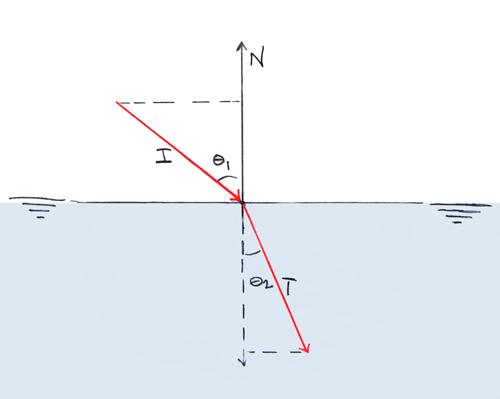Light which intersects a surface is incident. The light which passes through the surface is transmitted. The line perpendicular to a surface at a point p is normal to the surface at that point. According to Snell's Law, we can assign to each medium a constant value η (eta), called its index of refraction (IOR), which satisfies the following relationship:
(1) η1 sin θ1 = η2 sin θ2
where η1 and η2 are the indices of refreaction of the first and second media, respectively, θ1 is the angle between the incident ray and the surface normal, and θ2 is the angle between the transmitted ray and the normal.
In Fig. 1, incident ray I strikes a new medium, and the transmitted ray T is refracted. Each is shown as the hypotenuse of a triangle. If both I and T are drawn with a length of 1 (if they lie on a unit circle), then the opposite sides of the triangles will have lengths sin θ1 and sin θ2 (mouse over the image). According to Snell's law, the relationship between these two lengths and their corresponding angles is completely determined by the constant ratio η1/ η2:
Assumptions
{ Edit: this section has been reworked. I seek clarity in method and presentation. If a question appeared here and vanished, I will visit it at a later point. If you think I should retain, and strike, prior text ( i) The surface normal is vertical in the reference plane.
ii) The transmitted light will lie in the same plane as the incident ray and the surface normal. In the diagram, there is a single transmitted ray.
The first assumption is made for simplicity. For rigid geometric objects, relationships between angles are invariant under translation and rotation. For example, if you print out Fig.1 and set it in front of you on the table, spinning the page around will not change the measure of any of the angles. This problem is easier to solve for N = (0, 1) than for arbitrary N.
I assume (ii) as part of the definition of Snell's Law. That is, it is a physical result.
The difficulty is this. As mentioned in the nVidia paper, equation (1) alone does not appear to restrict T to the same plane as I and N. For, what is to prevent you from cheerily rotating T around the dotted line and forming a cone? Nothing. The interior angle remains θ2 all the way 'round. Thus, by the Who's Going to Stop Me Theorem T need not lie in the given plane. This may be done independently of a cheerful disposition.
However, I have given the incident ray and surface normal as vectors. Together, I and N give the plane in which T will lie. That is the point of the diagram. I will state the restriction mathematically and account for it later, when I move the result to 3 dimensional space.
Onward.
For computation on graphics hadware, it is desirable to express Snell's Law in vector notation. Thus,
Call the incident vector I, the normal to surface N, and the transmission vector T. Assume I, T and N are normalized (each has a length of 1), and all lie in the same plane. Then,
GIVEN: η1, η2, the indicies of refraction of the two media,
LET:
(2) N = (0, 1)
I = (–sinθ1, cosθ1)
T = (sinθ2, –cosθ2)
The dot product of two normalized vectors gives the cosine of the angle between them. Hence,
(3) I•N = cosθ1
I will also need the following trigonometric identity:
The Problem: Give T as a vector equation in η1, η2, N, and I.
I. Calculate T for any given η1, η2, N and I.
If I rewrite sinθ1, sinθ2 and cosθ2 in terms of cosθ1 = I • N, I can give each component of T as a vector equation. sinθ1 : By (3) and (4), sinθ1 becomes
sinθ2 : By Snell's Law (1), sinθ2 = (η1 /η2)sinθ1 and by (4),
cosθ2 : Substituting this value of sinθ2 into (4):
We can now give T = (sinθ2, -cosθ2):
This is correct, but in the vector T = (t1, t2), t1 and t2 have been solved separately. I seek slightly more than this; I want to solve both simultaneously. Hence,
II. Give T as the sum of two vectors.
Specifically, I want to write T as a linear combination of the two given vectors, N and I:
(9) T = αI + βN , α, β constant:
This is another way of writing a pair of equations, with unknowns α and β:
(10) sinθ2 = –α sinθ1
–cosθ2 = α cosθ1 + β
α: The first equation gives α directly. α = –(sinθ2/sinθ1) which, by (1), is
(11) α = –η1/η2
β: Substituting this value of α into the second equation,
(12) β = (η1/ η2)cosθ1 − cosθ2
Now the two steps can be merged. Using the values for cosθ1 and cosθ2 in (3) and (7),
Substituting the values for α and β in (11) and (13) into T = αI + βN gives the desired relation:

Excellent tutorial.
ReplyDelete